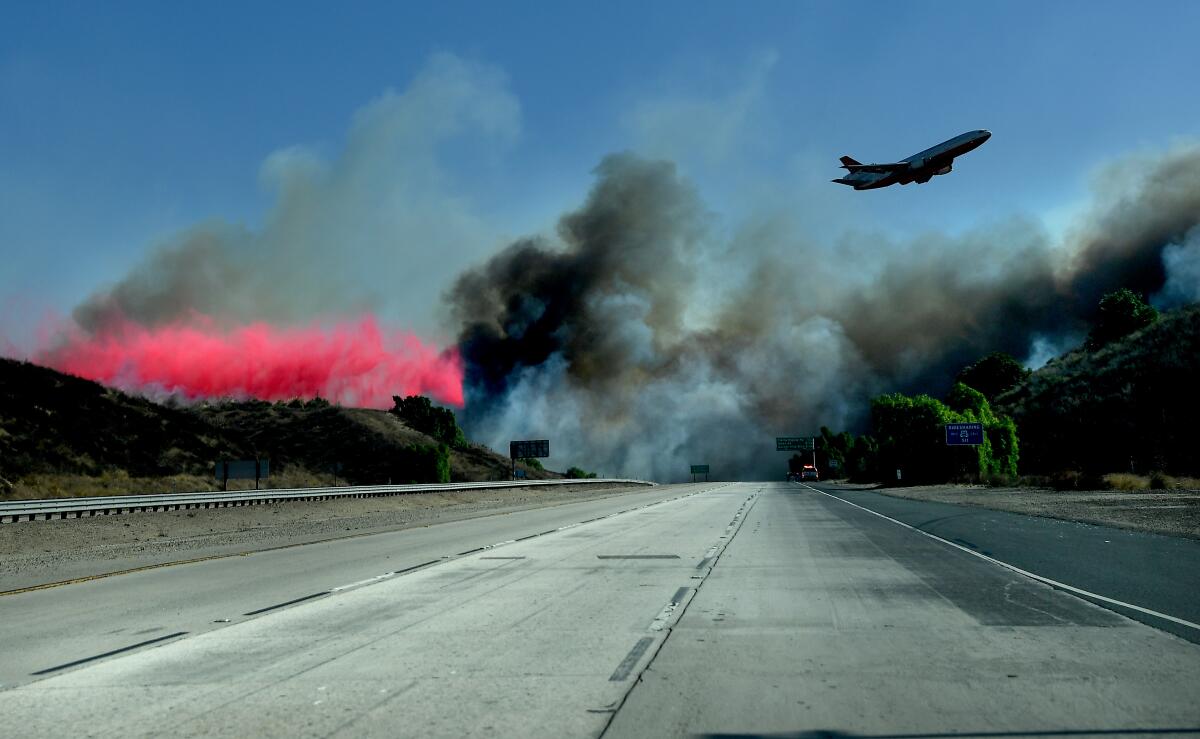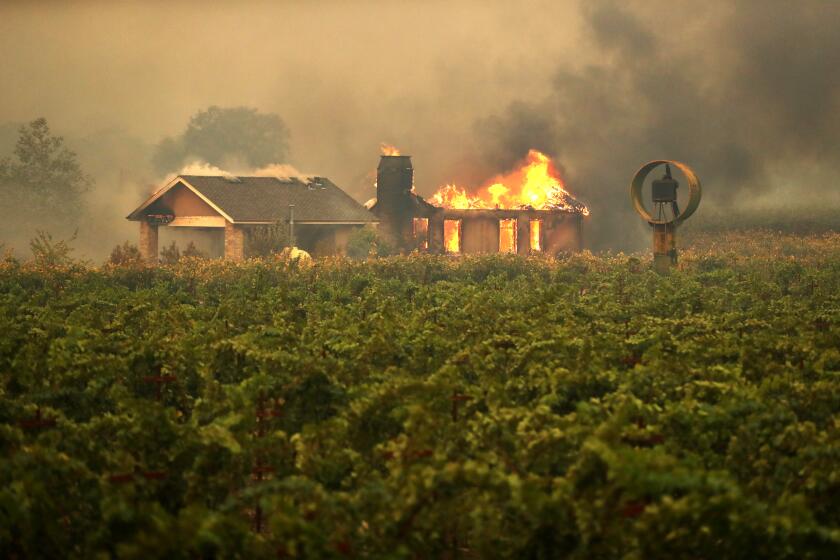News Analysis: A humbled California isn’t quite as special as we like to believe

- Share via
Now that the Kincade fire is mostly under control, and the Getty and Tick fires are smoldering, the questions will soon turn to whether we will rebuild what was lost.
The answer is, yes. OF COURSE, we will rebuild. And not only will we rebuild, we’ll probably rebuild in exactly the same, charred spots that are likely to burn again next year or maybe the year after that, thanks to the rapid acceleration of climate change and the Santa Ana and Diablo winds. We will rebuild, damn the long-term consequences. We will rebuild until the insurance companies say we cannot.
The real question is what does this strange determination say about us as Californians?
To me, it says that despite the way that many of us like to think of ourselves — enlightened and progressive, forward-thinking and open to change — the truth is, in some ways, we aren’t all that different from the rest of America, including those who live in the Midwest and South and, in our polarized political climate, are often characterized as backwards and short-sighted.
Californians have more in common with the residents of these redder, Trumpier parts of the country than we may think — a statement that, of course, cuts both ways and probably comes as a surprise to the many out-of-staters who took to social media this week to look down their collective noses at us and and our supposedly “unlivable” state.
At least that’s my conclusion now that I — a native Midwesterner — have survived my first fire season in Los Angeles and my fourth living in the state.
Many of us in California can’t understand why people in the Midwest are not only intent on mining coal and turning every creek bed a shade of stinky, sulfuric orange but also insist on filling the skies with carbon by burning it. After all, what rational person wants to come down with black lung disease or have a permanent crick in their neck and back from clambering through mines for a paycheck when there are plenty of perfectly safe, decent-paying jobs available with a little more education?
The answer is the calculation of risk versus reward.
The reason why the people in these states carry on in such an unhealthy way is the same reason Californians insist on paying thousands and even millions of dollars to live in a state that will surely kill us one day — if not by wildfire, then by earthquake, by flood, by drought, by volcano or by rental prices.
As I write this, residents displaced by last year’s Camp fire are rebuilding their homes in Paradise. This was a conflagration so awful, so unexpected, that it killed 86 people — the most in the state’s modern history. It destroyed about 90% of the city, or some 19,000 buildings. Tens of thousands of people, many of them elderly and poor, were left homeless.
But people are intent on rebuilding. They hope to make their community safer and more resilient against future fires. They also love where they live, an undeniably gorgeous swath of California, and many can’t afford to move somewhere else. And so they rebuild.
For the second time in three years, the residents of the Coffey Park neighborhood of Santa Rosa were forced to flee flames. This time was the Kincade fire bearing down on them. Many of the homes in this same neighborhood were wiped out by the Tubbs fire in 2017. Some were rebuilt and occupied again only recently.
The wildfires engulfing California this month have burned some of the same areas where other major fires have destroyed thousands of homes in recent years. But no one at the state level has formally proposed robust limits on home building in areas at risk of wildfire, even though a recent poll show voters support such restrictions.
In fact, just two weeks before the Kincade fire erupted, likely the result of a spark by PG&E equipment fanned by abnormally strong winds, residents had held an anniversary party to celebrate the rebirth of their neighborhood.
One family that refused to evacuate their new house in Coffey Park after losing their old one to the Tubbs fire summed up their defiance in a sign nailed to a tree on their property, as reported by my colleague Colleen Shalby.
“WE WILL BE BACK BETTER! STRONGER!”
Luckily, the flames of the Kincade fire never came. But even if they had, I’d be willing to bet that many of the homes would return one day when construction equipment could roll back into the rolling hills of Sonoma County. I suspect the same for the foothills where the Easy, Getty and Tick fires raged in Southern California.
In a poll conducted for The Times by the UC Berkeley Institute of Governmental Studies, three-quarters of California voters said there should be limits on home building in areas at high risk of wildfires. But politicians don’t buy that and neither do I.
Again and again, we’ve demonstrated that we believe the risk being here is worth the reward. And it absolutely is, even though plenty of people across the country continue to question the sanity of anyone who would choose to live in such a supposedly dangerous state.
We want to live right up along the beach even though the Pacific Ocean is sure to continue eating away at the shoreline in the coming decades. We want to live in houses perched on bluffs for the view, even though the chance of a mudslide taking us out grows more likely every year. We want to live among the redwoods, even though hellish wildfires are far more certain than in decades past.
Just like risking death from black lung disease is apparently worth it to save a dwindling number of jobs.
Or just like Southerners eating so much unhealthy food that they die young from preventable diseases is worth it because it’s delicious — something else many Californians, who prize a healthy lifestyle in all of its sometimes extreme forms, just can’t understand.
Mississippi has the highest rate of heart disease deaths in the country, and an equally high prevalence of diabetes among its residents. Louisiana, meanwhile, has one of the highest rates of obesity and physical inactivity. But as my relatives in Georgia have always said: “We’ve all got to die sometime.”
We’re all fatalistic. The difference between us and them isn’t how we make decisions but what lifestyles we choose to value, which is surely something to remember when we’re all straining to understand each other as the presidential election nears in 2020. We’re all, in essence, calmly driving through flames on either side of a freeway, while documenting our unsustainable, short-term thinking for our friends on Instagram.
So enough with the judgment, OK? I won’t judge your danger if you won’t judge mine.
More to Read
Sign up for Essential California
The most important California stories and recommendations in your inbox every morning.
You may occasionally receive promotional content from the Los Angeles Times.












